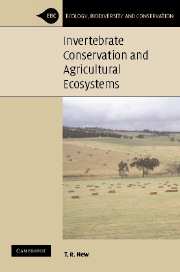Book contents
- Frontmatter
- Contents
- Preface
- Acknowledgements
- 1 Introduction: agricultural ecosystems and conservation
- 2 Agriculture and biodiversity: the place of invertebrates
- 3 Agriculture: effects on invertebrate diversity and conservation
- 4 Agricultural disturbance: diversity and effects on invertebrates
- 5 Biological control and invertebrate conservation
- 6 Cultural aspects of pest management
- 7 Extending beyond cropping areas
- 8 Field margins and landscape ecology
- 9 Pasture management and conservation
- 10 Towards more holistic management for invertebrates
- References
- Index
8 - Field margins and landscape ecology
Published online by Cambridge University Press: 29 July 2009
- Frontmatter
- Contents
- Preface
- Acknowledgements
- 1 Introduction: agricultural ecosystems and conservation
- 2 Agriculture and biodiversity: the place of invertebrates
- 3 Agriculture: effects on invertebrate diversity and conservation
- 4 Agricultural disturbance: diversity and effects on invertebrates
- 5 Biological control and invertebrate conservation
- 6 Cultural aspects of pest management
- 7 Extending beyond cropping areas
- 8 Field margins and landscape ecology
- 9 Pasture management and conservation
- 10 Towards more holistic management for invertebrates
- References
- Index
Summary
This chapter expands on the themes introduced in Chapter 7 to treat the wider aspects of landscape ecology involving cropping areas and field margins together as parts of a wider landscape, and their relevance in invertebrate conservation. Aspects of invertebrate distribution, movement patterns and population structure are integral to considerations of wider conservation in and around agroecosystems.
Introduction
Conservationists are concerned with properties of landscapes, because the interactions between their various components and features affect strongly the ecological systems present and the sustainability of ecological processes, and influence the wellbeing of various species occurring there. So-called ‘patch dynamics’ entails defining not only the properties of ‘patches’ (usually equated to ‘suitable habitats’) but also the ways in which boundaries and intermediate areas of the overall mosaic influence connections and communication between them through facilitating or impeding movements of organisms. As Chapman & Sheail (1994) noted, ‘a landscape of hedgerows of varied density, size and composition provides an obvious test-bed for such explorations in landscape ecology’. Broadly, the properties of linear features have substantial implications in broader conservation, and some exploration of those properties in relation to invertebrate wellbeing is highly relevant to wider conservation management of agroecosystems. Fry (1994) illustrated a variety of ecological features of field margins relevant to conservation management, emphasising the dual roles of margins as conservation assets and having roles in crop production and sustainability in farming systems (Fig. 8.1).
- Type
- Chapter
- Information
- Invertebrate Conservation and Agricultural Ecosystems , pp. 229 - 265Publisher: Cambridge University PressPrint publication year: 2005

